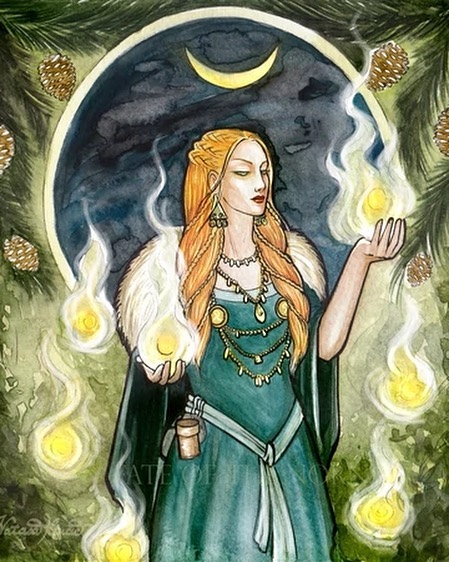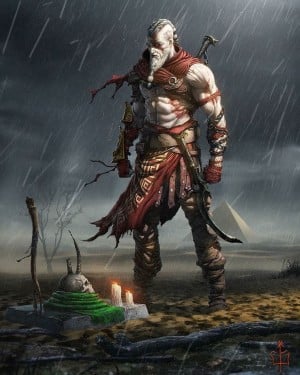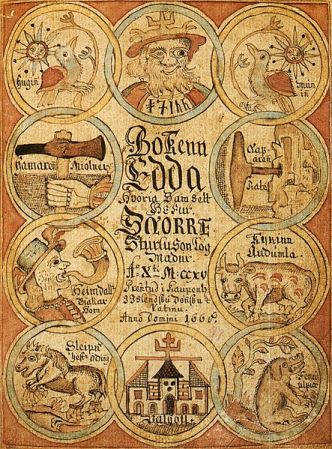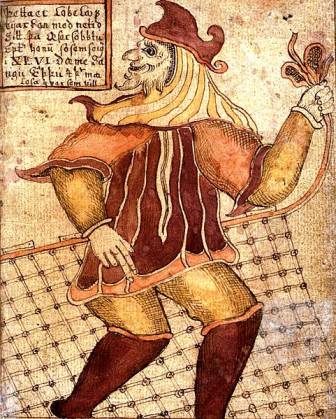In the vast tapestry of Norse mythology, Farbauti stands out as a jötun (giant) of significant intrigue. While not as frequently mentioned as some of his counterparts, his role and relationships within the mythos offer a fascinating glimpse into the world of the jötnar.
Farbauti Key Facts
| Parents | Unknown |
| Partners | Laufey |
| Siblings | Not specified |
| Offspring | Loki, Byleistr, Helblindi |
| Tribe | Jötun |
| Old Norse name | Fárbaute |
| Other names | “Cruel Striker” |
Name and Etymology
The Old Norse name “Fárbauti” is rich in meaning and offers a glimpse into the nature of this enigmatic jötun. It has been variously translated as “dangerous striker,” “anger striker,” and “sudden-striker.” This name is a compound, meticulously crafted from the noun “fár,” which denotes “hostility, danger, unfortunateness, falseness,” and the verb “bauta,” which means “to strike.” Such a name paints a vivid picture of a being who embodies sudden and dangerous force, perhaps reflecting his elemental association with lightning.
Regarding kennings, those poetic metaphors so integral to Old Norse literature, I’ve come across mentions that suggest Farbauti has specific kennings associated with him. However, to my knowledge, there are no kennings for him specifically. Instead, he is often mentioned in the context of being Loki’s father. So, while Farbauti does appear in these poetic expressions, they primarily serve to highlight his relationship with his more infamous son, rather than describe Farbauti himself.
Ancient roots
While Norse mythology is rich and varied, it often shares roots with other ancient mythologies. In the case of Farbauti, direct parallels in older mythologies like Germanic or Gothic are not evident. However, the concept of powerful and elemental giants is a recurring theme across many ancient cultures, suggesting a shared human fascination with such formidable beings.
Farbauti Origins
The origins of Farbauti, like many figures in Norse mythology, are shrouded in mystery. His parents are not explicitly mentioned in the ancient texts, leaving his lineage open to interpretation. However, what stands out is his union with Laufey, another jötun, suggesting that their offspring would inherit the characteristics and nature of the jötnar.
Farbauti’s most famous offspring is Loki, the trickster god known for his cunning and complex relationship with the Aesir gods. Loki’s lineage, being born of two jötnar, Farbauti and Laufey, adds another layer of intrigue to his character. This unique heritage might provide some insight into Loki’s multifaceted nature and his often ambiguous role in the Norse pantheon.
Farbauti Family and Relationships
Farbauti’s relationships, though not extensively detailed in the myths, are pivotal. His union with Laufey and the offspring they produced play a significant role in the Norse mythological landscape.
Laufey

Laufey, also known as Nál, is Loki’s mother, and while not well documented, believed to have been an Aesir. Their union is particularly noteworthy, not just for the offspring it produced, but also for the alliance it represents. Laufey herself, while not as extensively documented as her son Loki, holds a unique position within the world of the Aesir. Most of the unions between Aesir and jotnar are typically between Aesri gods taking jötun wifes or lovers. In the case of the relationship of Farbauti and Laufey this is changed. This might also, possibly allude to some reason why their son is known as Loki Laufeyjarson. The normal would have been the patronymic Loki Fárbautason, following his fathers name.
Loki
Loki, the offspring of Farbauti and Laufey, is a central figure in Norse mythology. His cunning, wit, and often duplicitous nature make him both an ally and adversary to the gods. Being born of two jötnar, Loki’s heritage is deeply rooted in the world of giants, which might offer some insights into his complex character and the roles he plays in various myths.
Byleistr and Helblindi
Byleistr and Helblindi, though less prominent than their brother Loki, are also children of Farbauti and Laufey. While not as extensively documented, their existence adds depth to Farbauti’s familial ties. Both, being born of jötnar, share the same elemental and powerful lineage, and while their roles in the myths might not be as pronounced as Loki’s, they further emphasize the significance of the jötnar in the Norse pantheon.
Farbauti Role And Depiction
Farbauti’s role among the jötnar is not as explicitly defined as some other figures in Norse mythology. However, his title “Cruel Striker” suggests a being of immense power and force. Among the jötnar, he might have been seen as a figure of authority or reverence, given his lineage and offspring.

For humans, Farbauti’s depiction would likely be that of awe and perhaps fear. The jötnar were often seen as forces of nature, elemental and raw. Farbauti, with his association with lightning and his imposing name, would undoubtedly be perceived as a powerful and potentially dangerous entity.
His personality, while not detailed extensively, can be inferred from his offspring, especially Loki. A blend of mischief, intelligence, and elemental force seems to run in the family, suggesting that Farbauti himself was a being of complexity and depth.
Play Jötunn Quiz
Do you want to learn more about the magical and powerful Jötunn? Then test your knowledge with this fun quiz game!
Don’t forget to play our other games as well!
Myths about Farbauti
Farbauti’s presence in Norse myths is often indirect, primarily through his offspring, especially Loki. However, there’s an intriguing anecdote that ties together the elemental nature of Farbauti, Laufey, and their infamous son, Loki.
The Birth of Wildfire
One of the most captivating tales associated with Farbauti revolves around the potential allegorical conception of Loki. With Farbauti’s name translating to “dangerous striker,” it can be seen as a metaphor for “lightning.” Laufey, Loki’s mother, has a name that can be associated with “leaves,” while another name for her, “Nál,” can be linked to “pine needles.” This union suggests a poetic representation of a lightning strike on dry foliage leading to a wildfire, with Loki’s nature mirroring the uncontrollable blaze.
Loki vs. Logi: A Name’s Significance
However, this interpretation hits a snag. The name “Loki” doesn’t mean “wildfire” in Old Norse; that’s “Logi.” Despite their similar names, Loki and Logi are different jötnar. In fact, they once competed in an eating contest, emphasizing their distinct identities. While the allegory of Farbauti and Laufey leading to the birth of wildfire is poetic, the presence of Logi as the actual embodiment of wildfire complicates this interpretation.
Mentions in Ancient Texts

Farbauti’s presence in Norse mythology is somewhat understated, with his mentions found solely in the Prose Edda. What’s interesting is that he’s primarily brought up in relation to being Loki’s father. It’s a bit like he’s in the background, with his son Loki taking the spotlight. This connection to Loki gives us a glimpse into Farbauti’s significance and his place in the grand tapestry of Norse tales.
Prose Edda
Gylfaginning
In “Gylfaginning” (‘The Beguiling of Gylfi’), a section of the Prose Edda, the enthroned figure of High provides insights into Loki’s lineage. He states that Loki is the offspring of the jötun Fárbauti and mentions “Laufey or Nál” as his mother. This source offers a clear connection between Farbauti and Loki, emphasizing the jötun heritage of the trickster god.
“His name is Loki or Lopt, son of the giant Farbauti. Laufey or Nal is his mother. Byleist and Helblindi are his brothers.” — Gylfaginning, 27–34.
Skáldskaparmál
In “Skáldskaparmál” (‘The Language of Poetry’), another section of the Prose Edda, Fárbauti is mentioned in the context of kennings that refer to his son, Loki. This section provides poetic expressions and metaphors that highlight the relationships and attributes of various figures in Norse mythology.
“How shall Loki be referred to? By calling him son of Farbauti and Laufey, of Nal, brother of Byleist and Helblindi…” — Skáldskaparmál, 8–16
Úlfr Uggason
The skald Úlfr Uggason provides a poetic reference to Loki, emphasizing his cunning nature and his lineage as “Fárbauti’s terribly sly son.” This mention underscores the significance of Farbauti’s lineage and the characteristics inherited by Loki.
“Renowned defender [Heimdall] of the powers’ way [Bifröst], kind of counsel, competes with Farbauti’s terribly sly son [Loki] at Singastein.” — Úlfr Uggason, Skáldskaparmál 16.
Frequently Asked Questions
Farbauti’s partner was Laufey.
In Old Norse, Farbauti translates to “Cruel Striker” or “Dangerous Hitter.”
Farbauti’s known children are Loki, Byleistr, and Helblindi.
Farbauti is a jötun, often referred to as a giant in Norse mythology.
Farbauti is Loki’s father.
While not frequently mentioned, Farbauti’s significance lies in his lineage and his offspring, especially Loki, who plays a central role in many Norse myths.
Featured Image Credit: thegeektopia via Instagram

